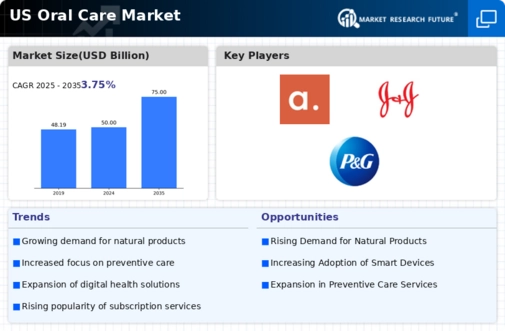The oral care market in the US is characterized by a dynamic competitive landscape, driven by innovation, consumer health awareness, and a growing emphasis on sustainability. Major players such as Procter & Gamble (US), Colgate-Palmolive (US), and Unilever (GB) are at the forefront, each adopting distinct strategies to enhance their market presence. Procter & Gamble (US) focuses on product innovation and digital marketing, aiming to capture the tech-savvy consumer segment. Colgate-Palmolive (US) emphasizes sustainability, with initiatives aimed at reducing plastic waste in packaging. Unilever (GB) leverages its global reach to introduce localized products that cater to regional preferences, thereby enhancing its competitive edge. Collectively, these strategies contribute to a moderately fragmented market structure, where competition is fierce yet collaborative, particularly in areas such as sustainability and digital transformation.
Key business tactics employed by these companies include localizing manufacturing and optimizing supply chains to enhance efficiency and responsiveness to market demands. The competitive structure of the oral care market appears to be moderately fragmented, with several key players exerting influence over market trends. This fragmentation allows for niche players to emerge, while larger companies maintain significant market shares through strategic partnerships and acquisitions.
In October 2025, Procter & Gamble (US) announced a partnership with a leading tech firm to integrate AI into its product development processes. This strategic move is likely to enhance product personalization, allowing Procter & Gamble (US) to better meet consumer needs and preferences. The integration of AI could streamline operations and foster innovation, positioning the company favorably in a competitive market.
In September 2025, Colgate-Palmolive (US) launched a new line of biodegradable toothpaste tubes, reinforcing its commitment to sustainability. This initiative not only addresses growing consumer concerns regarding environmental impact but also differentiates Colgate-Palmolive (US) from competitors who have yet to adopt similar practices. The move is indicative of a broader trend towards eco-friendly products in the oral care sector.
In August 2025, Unilever (GB) expanded its oral care portfolio by acquiring a niche brand specializing in natural ingredients. This acquisition is strategically significant as it allows Unilever (GB) to tap into the increasing consumer demand for natural and organic products. By diversifying its offerings, Unilever (GB) enhances its competitive positioning and aligns with current consumer trends favoring health-conscious choices.
As of November 2025, the oral care market is witnessing trends such as digitalization, sustainability, and the integration of AI technologies. Strategic alliances among key players are shaping the competitive landscape, fostering innovation and collaboration. The shift from price-based competition to a focus on technological advancement and supply chain reliability is evident. Companies are likely to differentiate themselves through innovative product offerings and sustainable practices, indicating a transformative phase in the oral care market.














Leave a Comment